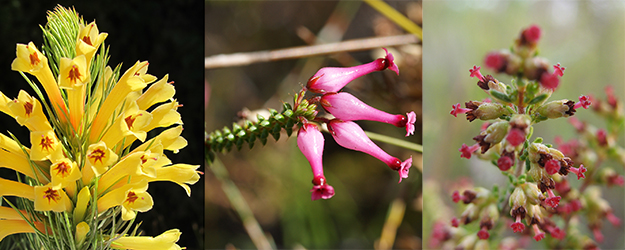20 May 2018
In order to research the mechanisms involved in speciation, Dr. Michael Pirie has selected a plant genus which actually originated in Europe but which has developed into an unbelievable number of varieties mainly in South Africa. The botanist, who works at the Institute of Organismic and Molecular Evolution (IOME) at Johannes Gutenberg University Mainz (JGU), has been following the trail of the Ericaceae (heather) family for a decade now.
Heather is a rather inconspicuous plant. Here in Germany, it mainly serves to fill up gaps in window flower boxes, as a durable decoration on graves or as a scene-setter for more seductive flowering plants in various flower beds. At most, we might be aware of it as the predominant plant on Lüneburg Heath; otherwise, heather hardly seems to register a mention here in Germany. However, when Dr. Michael Pirie talks about the Erica genus of plants, all of a sudden the spotlight is on heather.
Pirie doesn’t just want to talk about the plants; he wants you to see them, too. “It isn’t far,” he promises. And in indeed, it really isn’t far from the former Botanics building which, following the restructuring of the Faculty of Biology in early 2017 has housed part of the Institute of Organismic and Molecular Evolution (IOME), to JGU’s Botanic Garden. Here is there a flower bed dedicated to the little bushes so typical of heather.
The tree heath genome
“For many, this is just a boring green plant,” admits Pirie, “but there is so much more to it than that.” He points to a specimen with little white flowers. "The seeds for this and for many other varieties were sent to us by our colleague Jaime Fagúndez of the Universidad de La Coruna for research purposes." This plant is the Erica lusitanica, the Portuguese heath. Pirie has an interesting story about this plant: "There is another variety, the Erica arborea – the tree heath – which grows both in the Mediterranean region and in East Africa. If we have a plant like this that occurs in two different habitats but is not present in the regions between them, then we have to ask ourselves where it actually originated. In East Africa or in the Mediterranean? Erica lusitanica, which also belongs to the tree heath family, is very similar to Erica arborea."
In order to accurately clarify the relationship between the plants, Pirie and his colleagues compare their genomes section by section. This is complex but highly informative. "Parts of the Erica lusitanica genome are identical with those of several European heather varieties, even if the plants themselves sometimes don’t look at all similar. Other sections, on the other hand, are identical with those of Erica arborea. We can thus conclude that ancestors of Erica arborea must have hybridized with other varieties in Europe. The tree heath, as a single case, subsequently spread into Africa at a relatively late date. This contradicts the previous theory according to which relationships with European genuses are not particularly close. It was believed that the dispersal of Erica arborea represented an early phase of the distribution of heather in Africa, where it diversified into many different varieties. We, however, have thus been able to demonstrate that Erika arborea must have reached Africa completely independently of the other genuses.”
Pirie’s research focuses on the emergence and development of species. He wants to know under which conditions and within which periods of time they develop. He investigates this in the tropical rainforests of Central and South America using the example of the Annonaceae or custard apple family, but also with the help of the humble heather. "I have been working on both for years, but at the moment the Ericaceae are my main interest."
Diversity in the Western Cape
Pirie is British; in 2005 he wrote his dissertation in the Netherlands on the family of the Annonaceae. He worked for some time as a postdoc in Zurich before heading to Stellenbosch, South Africa, where in 2008 he commenced his research into heather under Prof. Dirk Bellstedt and Dr. E.G.H. Oliver. Finally, he then came to JGU in 2013. "In order to conduct research on custard apple trees, I travelled for two months in both Bolivia and Peru. But it is really hard to find exactly the right trees in the rainforest. My yield could be counted on the fingers of both hands.” But when it comes to heather plants, finding them is substantially easier.
There are around 800 species of Erica scattered across the world. "Only two dozen of these are in Europe. Most of them feature these little white to pink-colored flowers which are popular with insects.” The situation is completely different in the Western Cape region of South Africa. "There we can find approximately 700 different species across an area the size of Portugal.”
Pirie shows some photos of Western Cap heather. Its diversity of colors is surprising. "In South Africa, Erica has developed a wide range of strategies to encourage pollination.” One specimen projects bright yellow, elongated flowers into the air. "It is favored by sunbirds, the African counterpart to humming birds.” Until recently, the plant was still known by the scientific name Erica abietina spp. perfoliosa, but the genetic investigations undertaken by Pirie’s team have reassigned its family relationships, and it is now called Erica grandiflora spp. perfoliosa.
Landscape and climate
Erica retorta, on the other hand, produces pink, bottle-shaped flowers with a long, narrow neck. "These are visited by the so-called long-proboscid flies,” says Pirie. These are insects with particularly long mouthparts. "Others are even pollinated by mice, and we also have species such as Erica lasciva, which relies on pollination by the wind.”
For many years, Pirie and other specialists have known that: "The cradle of the heather plants is in Europe." So how can the diversity prevailing on the Western Cape be explained? Wouldn’t it be logical if the original region were to offer the largest spectrum? "Seen in genetic terms, this is in fact the case,” admits Pirie. And it is precisely this fact which proves that Erica originated in Europe. "But when we consider appearance and the number of species, everything looks very different.” Why this should be reveals much about the mechanisms of speciation, Pirie’s main research topic.
On the one hand, the past climate in Europe was not exactly to the taste of many heather plants. "10,000 years ago, the glaciers extended deep into this region. Climatic changes also occurred in the Cape region, but they weren’t as drastic.” This meant that plants were able to adapt. "In addition, the landscape around the Western Cape is highly diverse.” Folds in mountain ranges have divided it into numerous smaller regions which favor separate speciation; different altitudes offer different ecological niches.
A Heisenberg scholarship
The Western Cape acts like a naturally-developed laboratory for research on species formation in general, and in particular on the Erica genus. "You only need to walk for a few hours, and already you can gather an enormous amount of material. It is even enough to achieve statistically-relevant results." In the case of the custard apple trees, the process is much more difficult, but Pirie’s attention is turning back to them. "It is of course very illuminating to compare the speciation of completely different plant groups from different parts of the globe. This allows us to draw conclusions with regard to more general principles.”
For the next five years, the German Research Foundation (DFG) will be supporting Pirie’s work in the form of a Heisenberg scholarship. "This gives me the chance to plan on a longer-term basis and to procure further funding," says the botanist gratefully. Not only that, but he is more than happy with the framework conditions at JGU. "Here we have a herbarium collection, and living collections such as this bed with heather plants in it.” Both of these make his research, which he regards as having by no means come to an end, much easier. He will continue to investigate Erica and tropical trees as part of his quest to identify diversity mechanisms.



